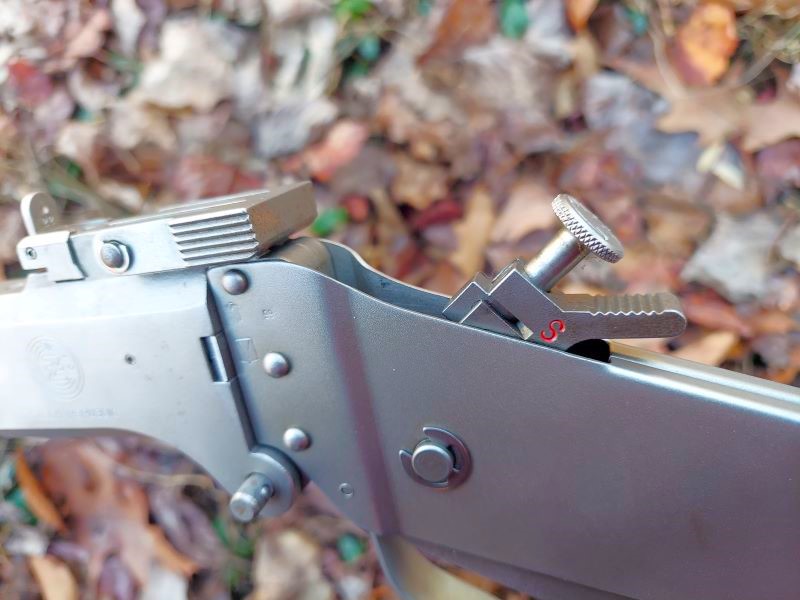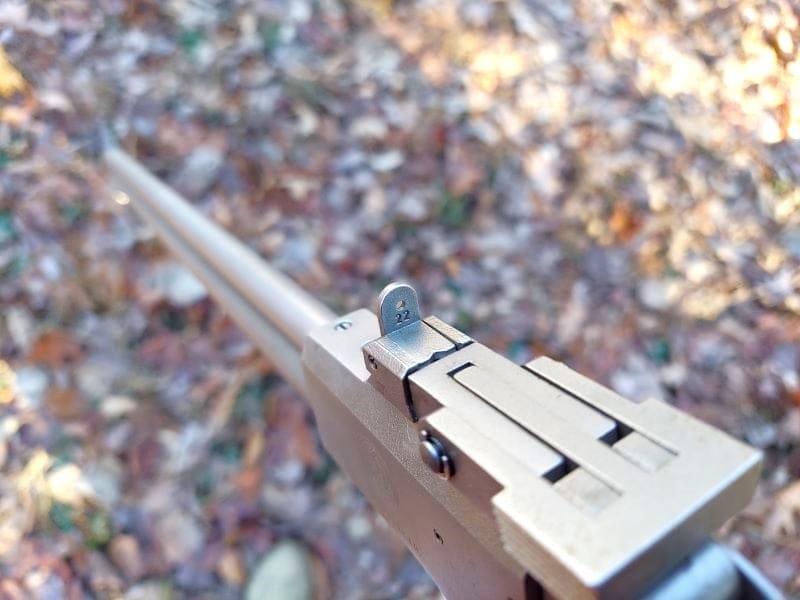In 1952, the M6 Aircrew Survival Weapon was issued to aircrews in the US Air Force. Considering that most air crash survivors were rescued within minutes, if not hours, of a crash, why would the military bother issuing such a firearm?
Because there were occasions when survivors had to spend days (or longer) behind enemy lines, in the wilderness, fending for themselves. Sometimes they had to walk or travel considerable distances to get to a place where they could safely get back to friendly lines.
The First Weapons
Initially, the M6 was made first by Ithaca, and then by Springfield Armory. Original models were made with 14-inch barrels. It was an over/under affair, with the top barrel being chambered in .22 Hornet and the bottom barrel in .410 shotgun.
Originals are very rare and fetch a hefty sum these days. And unfortunately, they are NFA weapons because the barrels are under the legal limit imposed by the ATF (16 inches is the minimum for a rifle and 18 inches for a shotgun). That makes obtaining one a complicated procedure when you can even find one.
The gun was a break action, which could be folded in half to save room for storage. Storage space aboard aircraft is at a serious premium, so these weapons had to fit into the survival pack that accompanied a pilot if he ejected from an aircraft.
The shooter selected which barrel would be fired by raising or lowering a knob on top of the hammer. The top position would fire the rifle, the middle position was the safety, and the bottom position fired the shotgun barrel.

Reloading was accomplished by breaking open the action and inserting rounds into the exposed chambers.
Construction
Both barrels were made from forged steel. The receiver and stock were made from stamped steel. The recoil pad and cheek rest were not made of metal, but rather a plastic material.
Trigger
There was no trigger. Instead, the piece was fired via a bar that was squeezed underneath the receiver. There was also no trigger guard. This made it easy to fire the weapon while the user was wearing mittens or gloves.
Sights
There was a front sight post. The rear sights were dual apertures (one sight for the .22 Hornet, the other for the .410 shotgun) that could be alternately flipped up.
Ammo Storage
One unique (and neat) aspect was that four .410 shells and nine .22 Hornet bullets were stored in the stock under the cheek rest, which was hinged. Just push a button and the cheekpiece lifted, exposing the stored ammunition underneath. The user would most likely have additional ammunition elsewhere, but the concept of having some onboard the weapon itself was a good idea.

.22 Hornet Ballistics
The .22 Hornet (5.6x35mm) came into existence in the early 1920s, although it wasn’t until 1933 that it went into widescale production. The late, great Townsend Whelen was a huge fan of the little cartridge.
Although its use is not as widespread today as it was in decades past, it’s still produced by such manufacturers as Federal, Nosler, Hornady, Remington, Winchester, and a few others.
The most common bullet weights used are 35-grain and 45-grain projectiles. Hornady states that their 45-grain Interlock ammunition has a velocity of around 2,665 feet per second, with their 35-grain Varmint Express Ammunition attaining around 3,100 feet per second. Granted, those velocities are probably out of longer barrels than the M6 uses, so velocities will be lower. However, we can see that the performance/velocity of the .22 Hornet far exceeds that of the .22 Long Rifle.
For varmints, small game, and small deer, the Hornet is effective and a good choice for the survival rifle.
Small Footprint
So how small was the M6 when it was folded in half? Just 15 inches! That’s quite a package to be able to store within 15 inches of space! Talk about using every single square inch of available storage!
Civilian Versions
Springfield Armory
Springfield Armory produced their version of the M6 Scout Rifle from the late 1970s until March of 2008. It’s a real shame that they discontinued production because this was a great little combo gun.
The SA version has 18½-inch barrels to keep it legal for anyone to purchase.

Most versions are chambered in the original .22 Hornet/.410 shotgun, which seems to be a good combination for practical purposes. This will allow the user to bag game up to small deer. Using bird shot in the .410 will bag birds and other small game. And in a pinch, the M6 could be used as a weapon.
There are also versions from Springfield Armory that used .22LR in place of the .22 Hornet. These would be practical from an availability and cost standpoint. .22 Hornet is a great performer, but it’s much more difficult to find and costs a lot more when we can find it. The .22LR is everywhere and economically priced.
Two finishes were available: one a dark parkerized finish much like that of the M-16. The other was a stainless steel finish.
The civilian version from Springfield Armory wears an unnecessary trigger guard, which is undoubtedly there because of liability. It prevents the little gun from being folded completely in half. There is a pin, however, that can be removed, separating the upper and lower receivers. Later versions of the M6 Scout used a captured pin similar to what we see on the M-16 series, which cuts down on lost pins.
Since Springfield Armory stopped producing the M6, they have now become collector’s items, with many owners being convinced that they own a piece of solid gold. A quick check of current prices, at the time of this writing, reveals that they’re listed for between $800 and $1,100. While they are excellent, useful firearms, those prices are not worth it to me.
TPS Arms
TPS Arms figured out that a gap existed in the market for this gun, and so they began producing it. They wisely kept a .410 shotgun barrel underneath as a standard. However, they offer a variety of rifle barrels, giving users a wide selection. Included among them are: .22 Long Rifle, .357 Magnum, .22 Hornet, .22 Winchester Magnum Rimfire, .17 HMR, and both barrels being .410 shotgun. Their website states that more caliber choices are on the way, too.
They’re to be applauded, in that they recognized the varied tastes of many people. These are versatile firearms!
The overall length is 32.25 inches, and it breaks down to 18.5 inches. As with the original M6, multiple rifle and shotgun rounds can be stored in the compartment in the buttstock. The weight is 5 lbs., 1 oz.
Interchangeable choke tubes (and a wrench to change them) are also included, adding further to the versatility. A captured takedown pin is used in this one as well.
We’re happy to see that someone recognized the popularity of this little takedown gun and that it’s being produced again. At some point, I may check this one out for a personal purchase. I have no experience with their quality, so I cannot say how good they are, but from what I’ve read, these are quality firearms.
Uses
Most of us aren’t aircrew members—so what are some realistic uses of this little combo gun these days?
This particular Springfield Armory M6 Scout that we tested for the article belongs to a friend of mine (no, he won’t sell it, don’t waste your time asking—I’ve already tried). He sometimes uses it to stow in his vehicle when on trips as one of those “Just In Case” pieces of gear. When you think about it, this isn’t too different than its original, intended purpose—which was as an emergency piece of kit for downed planes.

Whether we find ourselves in the wilderness needing to survive due to a mechanical breakdown, an air crash, or some other unforeseen malady, the end result is the same—we might need an emergency firearm.
The .410 shotgun offers very little recoil and is not unpleasant at all to shoot. Loaded with birdshot, it will take all sorts of small game, including feathered creatures. Of course, buckshot and slugs can also be utilized.
We’ve already discussed the merits of the .22 Hornet and its ability to take small and medium game. Together, the shotgun and rifle barrel are real winners! The .22 Hornet barely offers any recoil at all, even in such a light firearm.
The M6’s “trigger”, while heavy and with a long pull, really is not bad. After a little practice, one can easily get the pull down pat. I just place my trigger finger on the little hook at the base of the trigger bar and pull that. In this way, I can make accurate shots with the gun.

Although the sights are slightly crude, they are completely adequate for making reasonably accurate shots. We didn’t fire for groups on paper, but rather small, animal-shaped silhouettes at moderate ranges.
Conclusion
All in all, the M6 Scout concept is a sound one. It’s easy to break down and store in a pack if we’re heading out into the wilderness and desire something a little more than a pistol. For bush pilots flying in wilderness areas, it’s a good choice to store in the plane in the event of a crash. It also serves well for storing in a vehicle, just in case. Finally, some folks might just like to have one as a piece of interesting history to enjoy and use occasionally.
Whatever the intended use, it’s a practical, sensible piece of kit that provides the tools needed to take game during a crisis.


